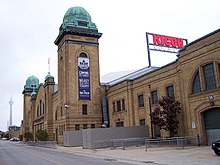Ricoh Coliseum
 |
|
 |
|
| Former names |
|
|---|---|
| Location | 45 Manitoba Drive Toronto, Ontario, Canada M6K 3C3 |
| Coordinates | 43°38′08.27″N 79°24′54.14″W / 43.6356306°N 79.4150389°WCoordinates: 43°38′08.27″N 79°24′54.14″W / 43.6356306°N 79.4150389°W |
| Public transit |
Exhibition GO Station Exhibition Loop |
| Owner | City of Toronto |
| Operator | Maple Leaf Sports & Entertainment |
| Capacity |
Ice hockey 7,851; 8,140 (including standing room) Concerts 9,250 |
| Construction | |
| Broke ground | 1920 |
| Opened | December 16, 1921 |
| Renovated | 1963, 1997, 2003 |
| Construction cost |
CA$1 million $3 million (1963 renovation) $38 million (2003 renovation) |
| Architect | George F.W. Price (original) Brisbin Brook Beynon, Architects (renovation) |
| Tenants | |
|
Toronto-Buffalo Royals (WTT) (1974) Toronto Marlies (AHL) (2005–present) Toronto Triumph (LFL) (2011-2012) Toronto Roadrunners (AHL) (2003–2004) |
|
Ricoh Coliseum is an arena at Exhibition Place in Toronto, Ontario, Canada, used for agricultural displays, ice hockey and trade shows. It was built for the Canadian National Exhibition (CNE) and the Royal Agricultural Winter Fair (the Royal) in 1921. It was formerly known as the CNE Coliseum. Since 1997, it has been part of the "National Trade Centre" (now known as the Enercare Centre) exhibition complex.
It serves as the home arena of the Toronto Marlies ice hockey team, the American Hockey League farm team of the Toronto Maple Leafs. For the 2015 Pan American Games the venue hosted the gymnastics competitions and was known as the Toronto Coliseum.
On January 1, 1920, Toronto voters approved by plebiscite a proposal by the Royal Agricultural Fair Association to construct, at a maximum cost of CA$1 million, a new arena for live stock. The City of Toronto (City) made a call for tenders in the fall of 1920 but the lowest tender was $1.9 million, exceeding the mandate approved by plebiscite. The size of the planned building was reduced by half in an attempt to get the cost under $1 million and a new call for tenders was done. The lowest tender received was from Anglin-Norcross Ltd. of Montreal for $892,000 to build the building to City Architect F. W. Price's specifications. There was reticence to hire a Montreal firm, and the city held off on awarding the contract while Price sought out construction offers from local firms to do the work using day labour, although the legality of this was questioned. Another issue raised was that the revised arena design needed to be expanded to meet the fair's needs. Anglin-Norcross offered to do the work at a further $31,000. It took two City Council votes, but Council finally approved the awarding of the contract to Anglin-Norcross on May 26, 1921. Demolition of existing buildings on the site commenced a few days later and arena work commenced in June 1921. The cornerstone was laid by Toronto Mayor Thomas Church on July 27, 1921 and Robert Fleming, President of the Canadian National Exhibition (CNE) declared that the building would be the largest of its kind in the world, with a floor space of 8.5 acres (3.4 ha).
...
Wikipedia
